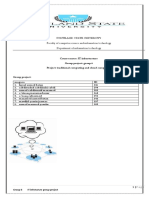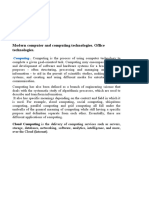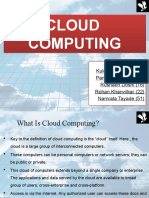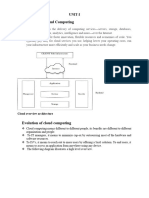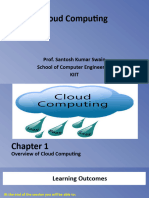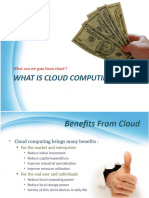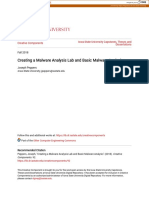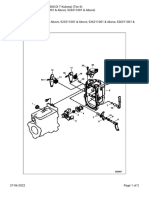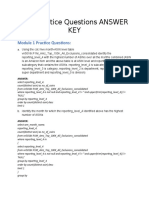TRADITIONAL
COMPUTING
Advantages and Disadvantages
Presented by:
Amor Ventolero Ferlie Bongcawel
Sheilla Mae Repato
Regine Salaquin Merry Lee Latic
WHAT IS
TRADITIONAL
COMPUTING?
Traditional computing refers to the conventional
approach to computing, where data processing is
performed on local servers, personal computers, or
mainframes.
It contrasts with cloud computing, which relies on
remote servers and the internet.
COMPONENTS OF
TRADITIONAL
COMPUTING
• Hardware: Physical devices such as
CPUs, RAM, storage, and networking
equipment.
• Software: Operating systems and
applications installed on local
machines.
• Networking: Localized data sharing
through wired or wireless connections.
• Storage: Data is stored in on-premises
storage systems (HDDs, SSDs, or data
centers).
1. Data Security & Control
All data is stored locally, reducing dependency
on external providers.
2. Customization & Optimization
ADVANTAGES Users can fully customize hardware and
software to meet specific needs.
OF TRADITIONAL
3. Performance & Reliability
COMPUTING On-premise systems often offer better
performance for intensive computing tasks.
4. Offline Access
Users can operate without an internet
connection, ensuring continued productivity.
DISADVANTAGES OF
TRADITIONAL COMPUTING
High Infrastructure Cost
– Requires significant investment
in hardware, software, and
maintenance.
Limited Scalability
– Expanding traditional IT
infrastructure requires
purchasing new equipment.
Maintenance & Management
– IT teams must regularly update,
repair, and manage local
systems.
Disaster Recovery Risks
– Data loss can occur due to
hardware failures or cyber
threats if backups are not
maintained properly.
TRADITIONAL VS. CLOUD
COMPUTING COMPUTING
Data Storage Remote Internet-based
Scalability Limited Highly scalable
Cost High upfront cost Pay-as-you-go
Accessibility Limited to physical location Anywhere
Maintenance Requires IT management Managed by provider
CONCLUSION
• Traditional computing remains relevant for
businesses needing full control over their data and
operations.
• However, it has limitations in cost, scalability, and
remote accessibility.
• Organizations today often adopt a hybrid approach,
combining traditional computing with cloud
solutions.
KEY POINTS and
Characteristics
OF TRADITIONAL COMPUTING
Presented by
Mariel Torilla Lea Marco Arjine Galapate
Marian Garing Aramae Dionaldo 1
WHAT IS TRADITIONAL
COMPUTING?
Definition Why it matters Key benefit
Also known as on-premises It is reliable, widely compatible, Its reliability and stability—it
computing, involves owning and cost-effective, secure, and efficient provides consistent performance,
managing physical hardware and for most applications. It serves as well-established security, and
software, offering control, security, the foundation for emerging broad software compatibility,
and data ownership, but requiring technologies like AI and quantum making it essential for businesses,
significant investment and computing while remaining individuals, and technological
maintenance. essential for businesses, security, advancements.
and everyday digital tasks.
General- Security &
KEY POINTS Purpose Use
Can handle a wide
Control
Provides established
range of tasks, from security protocols and
basic applications to direct user control over
complex computations. data.
Reliability & Software
Stability Compatibility
Supports most operating
Proven technology that
systems, applications,
delivers consistent and
and programming
predictable
languages.
performance.
Scalability Foundation for
KEY POINTS Can be upgraded with
more storage,
processing power, and
Innovation
Supports and integrates
with AI, cloud
peripherals.
computing, and
emerging tech.
Affordability & Energy
Accessibility Efficiency
Optimized power
More cost-effective and
consumption compared
widely available
to advanced
compared to emerging
technologies like
technologies.
quantum computing.
CHARACTERISTICS
On-premise High Control Customization Limited Scalability
Infrastructure Users have complete Potential Expanding capacity
All hardware, software, control over their system Ability to customize often requires buying
and data reside within a configuration and can software and hardware new hardware, which
company's physical tailor it to specific needs. to fit unique can be time-consuming
location. requirements. and costly.
CHARACTERISTICS
High Upfront Cost Dedicated IT Staff Data Security Less Flexibility for
Initial investment in Required Concerns Remote Access
hardware, software, and Expertise needed to While data is physically Compared to cloud
maintenance personnel manage and maintain secured, maintaining computing, accessing
can be significant. the infrastructure. robust security measures data from different
is crucial. locations can be
challenging.
CLUSTER COMPUTING
ADVANTAGES and DISADVANTAGES
WHAT IS CLUSTER COMPUTING?
Cluster Computing
Cluster computing is a type of parallel and distributed
computing that uses multiple computers, called nodes,
connected by a high-speed network to work together as a
single system. These nodes share resources and collaborate to
solve complex computational problems or provide high
availability and scalability for applications. Instead of relying
on a single powerful machine, cluster computing leverages the
combined power of many less powerful machines, making it a
cost-effective and highly scalable solution
EXAMPLES OF CLUSTER COMPUTING APPLICATIONS
The number of nodes in a cluster can range from a few to thousands,
depending on the computational demands.
Scientific Research: Simulating complex Cloud Computing: Providing scalable
phenomena like weather patterns, climate and reliable infrastructure for cloud
change, or molecular interactions. services.
Big Data Analytics: Processing and analyzing
massive datasets to extract insights and E-commerce: Handling high volumes
patterns. of transactions and maintaining
website availability during peak
Artificial Intelligence (AI) and Machine demand.
Learning (ML): Training large AI models and
performing complex machine learning tasks.
ADVANTAGES OF CLUSTER COMPUTING
High Computational Power: Cluster computing enhances computational capabilities
and enables efficient handling of complex calculations and large datasets through
parallel processing, using multiple interconnected computers. Workload sharing leads
to improved performance and faster execution times compared to single-machine
solutions.
Cost-Effectiveness: By using affordable, off-the-shelf hardware, cluster computing
delivers performance similar to high-end systems at a lower cost.
Scalability: You can easily add nodes to increase computing power without replacing
existing systems, allowing flexible growth as demands increase.
High Availability: Designed with redundancy, cluster computing ensures high
availability. The system can quickly switch to a backup if a critical component fails,
minimizing downtime and maintaining service access.
ADVANTAGES OF CLUSTER COMPUTING
Fault Tolerance: Cluster computing can continue operating by
redistributing workloads among the remaining servers, minimizing
downtime and data loss, if one or more nodes fail.
Resource Sharing: Resources like CPU, memory, and storage are
dynamically shared among nodes, ensuring efficient hardware utilization.
Flexibility: Cluster computing can be upgraded to a superior specification
or extended through the addition of additional nodes.
DISADVANTAGES OF CLUSTER COMPUTING
Expensive Setup and Maintenance: Establishing a cluster computing system requires a
significant financial investment, including hardware, networking equipment, and software
licenses. Ongoing maintenance costs, such as updates and hardware replacement, can
quickly accumulate, making it less accessible for smaller organizations with limited budgets.
Limited Scalability: Expanding the cluster can lead to issues with load balancing, resource
management, and network latency. Scaling often requires substantial software adjustments or
architectural changes, which can introduce complexity and downtime.
Requires Specialized IT Expertise: Managing a cluster computing environment requires
specialized personnel familiar with distributed systems and networking. This requirement can
pose challenges in recruitment and lead to higher operational costs, especially in high
turnover environments.
Complexity: Setting up and managing cluster computing can be complex, requiring expertise
in areas such as networking, distributed systems, and parallel programming.
Presented by:
Derek John Bayawa
Justin Banlat
Bea Ragusta
Melca Audeje
Difference between Cloud
Computing and Traditional
Computing
Cloud computing delivers services over the
internet using remote servers, offering scalability
and accessibility. Traditional computing relies on
local servers, requiring upfront hardware
investments and maintenance. The key distinction
lies in where and how services are hosted,
impacting flexibility, cost-effectiveness, and ease
of access.
Difference between Cloud
Computing and Cluster
Computing
Cloud Computing refers to the on demand delivery of the IT
resources especially computing power and data storage through
the internet with pay per use pricing. It generally refers to the data
centers available to the users over internet. Cloud Computing is
the virtualized pool of resources. It allows us to create, configure
and customize our applications online.Cluster computing refers
to the process of sharing the computation task to multiple
computers of the cluster. The number of computers are
connected on a network and they perform a single task by
forming a Cluster of computers where the process of computing
is called as cluster computing.
CLOUD COMPUTING
CLUSTER COMPUTING
Difference between Cloud Computing and Cluster
Computing :
Serial Number Category Cloud Computing Cluster Computing
Providing on demand IT resources Performing a complex task in a
1. Goal
and services. modular approach.
Specific assigned resources are Specific assigned resources are
2. Resource Sharing
not shareable. not shareable.
In cloud computing there is In Cluster Computing there is
3. Resource type
heterogeneous resource type. homogeneous resource type.
Virtualization hardware and
4. Virtualization No virtualization resources.
software resources.
Security through isolation can be Security through node
5. Security
achieved. credential can be achieved.
Initial capital cost for setup is very
6. Initial Cost Initial capital cost for setup is very
low.
7. Security Requirement Very low Very high
8. Maintenance Requires low maintenance. Requires little more maintenance.
No hardware requirement More hardware requirement
9. Hardware
physically. physically.
10. Node OS Multiple OS runs in VM Windows, Linux
User management is centralized
11. User Management or decentralized to vendor/third User management is centralized.
party.
12. Scalability Allowed Limited
In Cloud Computing User chosen In Cluster Computing Cluster
13. Architecture
architecture. oriented architecture
Dynamic computing Tightly coupled
14. Characteristic
infrastructure/resources/services systems/resources
In cloud computing application In cluster computing application
15. Software Dependent
domain independent software. domain dependent software.
16. Example Dropbox, Gmail Sony PlayStation clusters
Thank you for
Your attention!

























